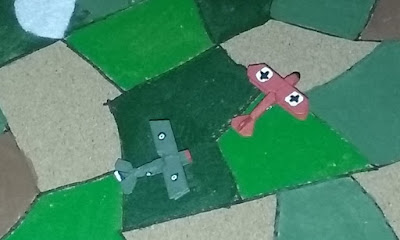Sam "Snoopy" Brown is patrolling in his Sopwith Camel when he spots a familiar red Fokker Triplane. "The Red Baron!" Both aircraft head towards each other.
Game Notes - I played this scenario on my bulletin board, which measures approximately 15" x 20". I was worried that the move distances were too long for the board so I used centimeters instead (e.g. a 6" move became a 6 cm move).
The Red Baron outmaneuvers "Snoopy." Bullets lash through his craft.
The enemies engage in a turning battle. Again the Red Baron fires and damages "Snoopy's" plane.
The Red Baron's experience pays off! He gets on Snoopy's tail; he has him dead to rights . . . and he completely misses. A lucky break for "Snoopy."
Game note - no hits on 4 dice!
The Red Baron outmaneuvers "Snoopy" again. This time he he does not fail.
Fortunately, "Snoopy" is a star and manages to crash land his plane. Though injured, he survives the fight.
After recuperating, "Snoopy" is back up in the air. This time he spots an Albatross.
Game Note - I enjoyed the first scenario so I decided to try another one. This time I'm using a slightly easier opponent. I also wanted to see what would happen if I used longer movement rates so it's back to inches.
The opponents try to line up a shot but the clouds block their view.
Game Note - I did not use any spotting rules for this trial, however clouds block line-of-sight.
"Snoopy" loses sight of his quarry.
Game Note - One of the drawbacks of longer movement; it's easier to really miss each other.
He re-engages and finds that he outclasses his opponent. He lines up a shot and begins to damage the Albatross.
Game Note - I rolled for the Albatross' quality and ended up with an inexperienced pilot. Between that and the Camel's superior maneuverability, "Snoopy" had a decided advantage.
"Snoopy" gets on the Albatross's tail. More shots do damage.
Closing in for the kill.
But the Albatross pulls off a sideslip and "Snoopy" zooms by. The tables are turned!
But not for long. The agile Camel gets on the enemy's tail, The Albatross is severely damaged!
The Albatross makes a break for home but "Snoopy" brings him down.
Analysis
How did S&LG do with respect to my wish list?
Solo-ability = High
Because the rules feature sequential movement they are quite easy to play solo.
Scale-ability = To Be Determined
I suspect that this will be high but I would like to test it out first. I'd like to try out an escorted bombing run and see how that goes.
Look and Feel = High
Not surprisingly, the planes with the advantage in pilot quality and/or aircraft maneuverability won both dogfights. The rules seemed to provide appropriate bonuses. I was especially pleased with the rules for pilot quality; I thought they very accurately rewarded the better pilot.
Tactical Thought = High
I was surprised by this. In my experiences, movement allowance systems usually make it too easy for the plane moving last to get into position. S&LG mitigates this in 2 ways. First, the player declares his speed (how far to move) before measuring. This creates an interesting range estimation challenge. Secondly, the players must roll to see how much they can turn their planes. A bad roll could prevent the plane from lining up a shot. These factors made the rules eminently more satisfying than the typical movement allowance game.
Portawargameability = Medium
These rules can be played in a very compact area. My test board was, as I mentioned, approximately 15" x 20". They can be played with few components so it is very easy to set up a game. Finally, the rules themselves are quick and easy to play, perfectly in accord with the spirit of portable wargames.
However, I downgraded S&LG slightly due to two factors:
- "Large" board - I believe the suggested board size is 2' x 2' which is not really large. However, I'm working on games that can fit into an A4 sized box (approximately 8.5" x 12"). My land warfare boards are a tiny 8" x 8" and I'd like to fit a dogfight game onto a similar board. I may be able to use 2 8.5" x 11" boards joined together instead.
- Not gridded - portable wargames traditionally make use of a gridded board, and I am particularly fond of grids. With its turns measured in 45 degree increments, I'm not sure how well it would adapt to a grid (although I may try it).
Admittedly, these are just niggardly quibbles. Nevertheless, they reflect my gaming preferences (or biases if you will) and thus the score is an accurate reflection of how well the rules meet my desires.
Adaptability = High
I haven't tested this either but I am confident that they can be made to work with later periods. The aircraft stats are not overly long or complicated so it should be fairly simple to work up stats for any plane you wish!
Final Thoughts
As I mentioned, I was hesitant to try these rules because they used some features for which I did not care. I must say that I am pleasantly surprised. Compared to a great many rules sets, some of them commercially available, S&L
Of course, being a typical wargamer, I can't leave well enough alone. I have some ideas for tweaks to the rules and plan to experiment. I also haven't given up on creating some rules using maneuver templates and will continue experimenting in that direction.
Overall, these are very good rules for some quick air actions. I'm pleased enough with them that I will be making a change to my 6 x 6 Challenge. Instead of my Lumbago colonial project, I will henceforth add Spandaus and Lewis
























